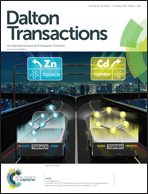Integrin-targeted delivery into cancer cells of a Pt(iv) pro-drug through conjugation to RGD-containing peptides†
Abstract
Conjugates of a Pt(IV) derivative of picoplatin with monomeric (Pt–c(RGDfK), 5) and tetrameric (Pt–RAFT-{c(RGDfK)}4, 6) RGD-containing peptides were synthesized with the aim of exploiting their selectivity and high affinity for αVβ3 and αVβ5 integrins for targeted delivery of this anticancer metallodrug to tumor cells overexpressing these receptors. Solid- and solution-phase approaches in combination with click chemistry were used for the preparation of the conjugates, which were characterized by high resolution ESI MS and NMR. αVβ3 and αVβ5 integrin expression was evaluated in a broad panel of human cancer and non-malignant cells. SK-MEL-28 melanoma cells were selected based on the high expression levels of both integrins, while CAPAN-1 pancreatic cancer cells and 1BR3G fibroblasts were selected as the negative control. Internalization experiments revealed a good correlation between integrin expression and the cellular uptake of the corresponding fluorescein-labeled peptides and that the internalization capacity of the tetrameric RGD-containing peptide was considerably higher than that of the monomeric one. Cytotoxic experiments indicated that the antitumor activity of picoplatin in melanoma cells was increased by 2.6-fold when its Pt(IV) derivative was conjugated to c(RGDfK) (IC50 = 12.8 ± 2.1 μM) and by 20-fold when conjugated to RAFT-{c(RGDfK)}4 (IC50 = 1.7 ± 0.6 μM). In contrast, the cytotoxicity of the conjugates was inhibited in control cells lacking αVβ3 and αVβ5 integrin expression. Finally, cellular uptake studies by ICP-MS confirmed a good correlation between the levels of expression of integrins, intracellular platinum accumulation and antitumor activity. Indeed, accumulation and cytotoxicity were much higher in SK-MEL-28 cells than in CAPAN-1, being particularly higher in the case of the tetrameric conjugate. The overall results highlight that the great ability of RAFT-{c(RGDfK)}4 to bind to and to be internalized by integrins overexpressed in SK-MEL-28 cells results in higher accumulation of the Pt(IV) complex, leading to a high antitumor activity. These studies provide new insights into the potential of targeting αVβ3 and αVβ5 integrins with Pt(IV) anticancer pro-drugs conjugated to tumor-targeting devices based on RGD-containing peptides, particularly on how multivalency can improve both the selectivity and potency of such metallodrugs by increasing cellular accumulation in tumor tissues.


 Please wait while we load your content...
Please wait while we load your content...